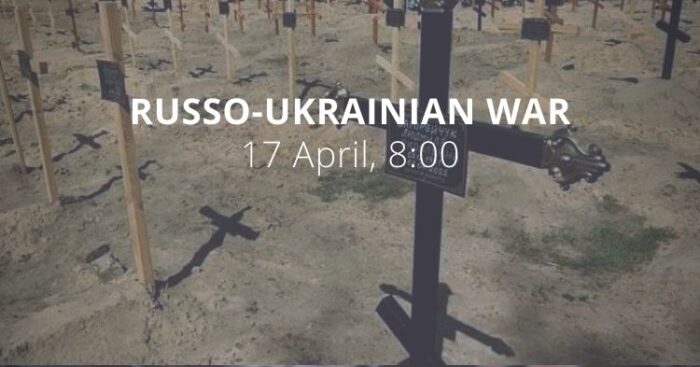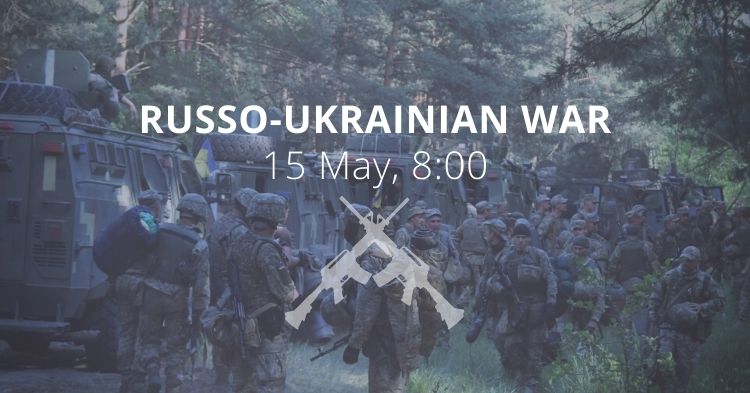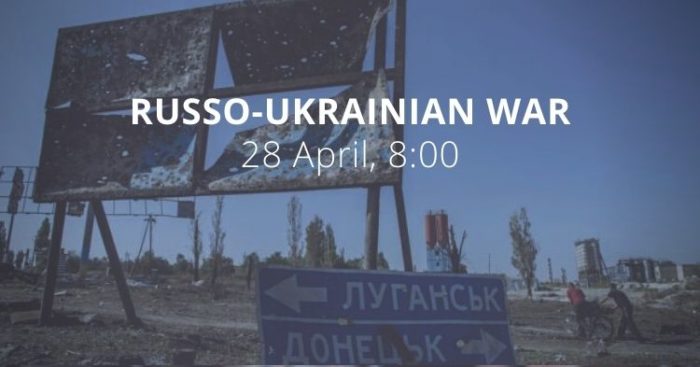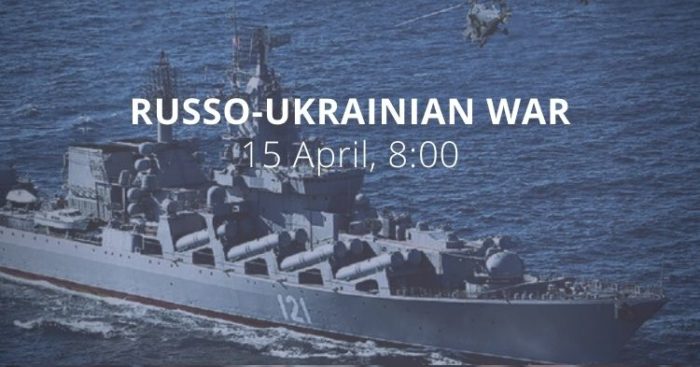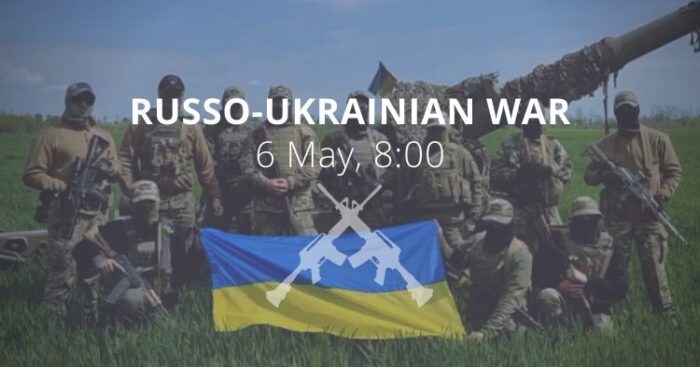Morning report day 53 – April 17
Situation
According to information from the General Staff:
“The Russian Federation continues its full-scale armed aggression against Ukraine. Russian forces launched air and missile strikes on infrastructure and residential areas involving air and sea components. In the Volyn and Polissya directions, the enemy did not take active action. Certain units of the Armed Forces of the Republic of Belarus continue to carry out tasks to cover the Ukrainian-Belarusian border in the Brest and Gomel regions. In the Siversky direction, there is a possibility of missile strikes and artillery shelling from the territory of the Russian Federation on military and civilian infrastructure in the Chernihiv and Sumy regions. There are no changes in the composition and position of the Russian enemy forces in the Slobozhansky direction. The Russian occupiers continue to partially block the city of Kharkiv and shell its residential areas. Russians heavily shelled the center of Kharkiv. At least 5 people were killed. The city center was shelled at about 13:30 and 14:00. As of 15:00, there are also 13 wounded,–Kharkiv Health Depart.told Suspilne https://t.co/gzAhmb2c1R pic.twitter.com/UdqhmQ0etS — Euromaidan Press (@EuromaidanPress) April 17, 2022 In the Donetsk and Tavriya directions, the Russian forces continued to launch airstrikes on Mariupol. Conducted assault operations near the seaport. 🇷🇺units of the 810th &155th Marine brigades are being prepared for landing naval operation in Mariupol.The information is currently being clarified — Euromaidan Press (@EuromaidanPress) April 17, 2022 In the Pivdennyi Buh direction, the Russian forces’ main efforts are focused on maintaining their positions. According to the available information in the unrecognized Transnistrian Moldavian Republic, with the participation of representatives of the Federal Security Service of the Russian Federation, the combat capability of the 1st, 2nd and 3rd separate motorized rifle brigades of the Transnistrian armed forces was tested. The inspected units are not ready for combat operations. Thirteen air targets were hit by the Air Force of the Armed Forces of Ukraine in the previous day: one plane, one helicopter, five UAVs and six cruise missiles.” “The Russian Federation continues its full-scale armed aggression against Ukraine. Russian forces launched air and missile strikes on infrastructure and residential areas involving air and sea components. In the Volyn and Polissya directions, the enemy did not take active action. Certain units of the Armed Forces of the Republic of Belarus continue to carry out tasks to cover the Ukrainian-Belarusian border in the Brest and Gomel regions. In the Siversky direction, there is a possibility of missile strikes and artillery shelling from the territory of the Russian Federation on military and civilian infrastructure in the Chernihiv and Sumy regions. There are no changes in the composition and position of the Russian enemy forces in the Slobozhansky direction. The Russian occupiers continue to partially block the city of Kharkiv and shell its residential areas. In the Donetsk and Tavriya directions, the Russian forces continued to launch airstrikes on Mariupol. Conducted assault operations near the seaport. In the Pivdennyi Buh direction, the Russian forces’ main efforts are focused on maintaining their positions. According to the available information in the unrecognized Transnistrian Moldavian Republic, with the participation of representatives of the Federal Security Service of the Russian Federation, the combat capability of the 1st, 2nd and 3rd separate motorized rifle brigades of the Transnistrian armed forces was tested. The inspected units are not ready for combat operations. Thirteen air targets were hit by the Air Force of the Armed Forces of Ukraine in the previous day: one plane, one helicopter, five UAVs and six cruise missiles.” 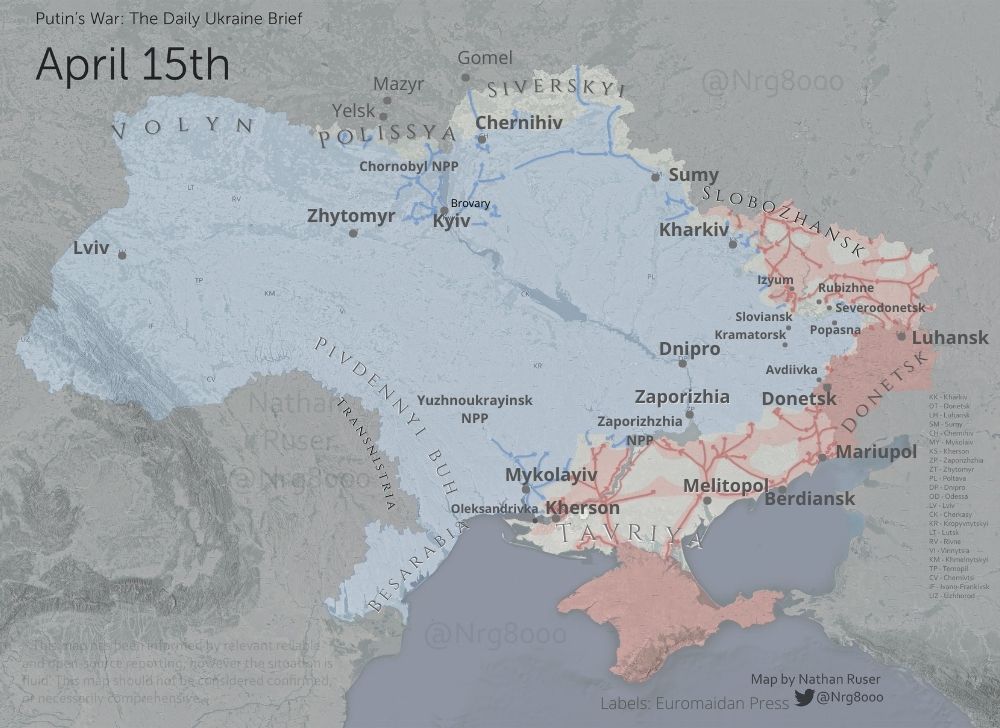
🇷🇺conducted assault operations near the seaport, continued to launch airstrikes on Mariupol–🇺🇦Gen.Staff,6:00 https://t.co/ojHS4g6YIO
According to intelligence, there are 39 Russian warships or boats near the city of Sevastopol in the Russian-occupied Crimea, Ukrayinska Prada reports. As of April 15, 39 warships/boats were located near Sevastopol, including 9 large landing ships.
Aggressors going all in to seize Mariupol – hostilities getting fiercer, Ukrinform reports. In Mariupol, highly intense firefights are underway as the Russians are throwing in more forces to storm the city, using weapons of mass destruction, according to Petro Andriushchenko, the advisor to the city mayor. “Mariupol. Dy 52 of heroic resistance. As for now: hostilities are becoming fiercer. The occupiers are throwing all forces in, storming the city. The appearance of TU bombers speaks of the intention to launch an assault on the Azovstal stronghold and the seaport after dropping high-yield bombs such as FAB-3000 and others,” Andriushchenko wrote.
Ukrainian General Staff has reported on the Russian manning and logistic challenges:
- The movement of Russian units to the territory of Ukraine from the Kursk, Bryansk and Voronezh regions continues. Units of the armed forces of the Russian Federation stationed on Ukrainian territory have significant supply problems. At the same time, they were able to accumulate significant stocks of ammunition.
- The dissatisfaction of personnel is growing in the units of the Russian occupiers on the line of direct fire contact, and the moral and psychological condition remains low. The Russian military is constantly complaining about the lack of rotation, equipment that is constantly failing, the quality of fuel supplied and food.
- Due to hostilities on the territory of Ukraine, the rotation of units of the 68th Army Corps of the Eastern Military District in the Syrian Arab Republic has been postponed.
- According to the available information, the military enlistment offices of the Central Military District of the Armed Forces of the Russian Federation are agitating conscripts who are in reserve to sign short-term contracts for a period of 3 months to 1 year.
- At the same time, there is a decrease in the level of moral and psychological condition of units of the 1st Army Corps operating in the Donetsk direction. This is due to the significant losses of units, which were replenished at the expense of the mobilized.
According to British Defense Intelligence, (last 24 hours):
Russian forces continue to redeploy combat and support equipment from Belarus toward eastern Ukraine. This includes locations close to Kharkiv and Severdonetsk.
- Russian artillery continues to strike Ukrainian positions throughout the east of the country where Russia plans to renew its offensive activity.
- Though Russia’s operational focus has shifted to eastern Ukraine, Russia’s ultimate objective remains the same. It is committed to compelling Ukraine to abandon its Euro-Atlantic orientation and asserting its own regional dominance.
As of Sunday 17.04.2022, the approximate losses of weapons and military equipment of the Russian Armed Forces from the beginning of the war to the present day:
- Personnel – more than 20300 people (+200),
- Tanks – 773 units (+11),
- Armored combat vehicles – 2002 units (+20),
- Artillery systems – 376 (+5),
- Multiple rocket launchers – 127 (+2)
- Air defense means – 66 (no change),
- Aircraft – 165 163 (+2),
- Helicopters – 146 (+1),
- Automotive technology – 1471 (+13),
- Vessels/boats – 8 units (no change),
- Fuel and lubricant tanks – 76 (no change),
- UAV operational and tactical level – 148 (+10)
- Special equipment – 27 (+1)
- Mobile SRBM system – 4 (no change)
Humanitarian
There is an increase in passenger traffic; since the beginning of April, about 400,000 people have entered Ukraine, including previously evacuated citizens, Ukrainska Pravda reports. According to the State Border Guard Service of Ukraine, more than 900,000 people crossed Ukraine’s western borders with the EU and Moldova from April 2 to 15. 400,000 people entered and more than 500,000 left Ukraine.
According to UNHCR 4,836,445 refugees have been registered as of April 15. The UN says that so far Poland has taken in 2,744,778 refugees, Romania 732,473, Russian Federation 484,725, Hungary 454,098, Republic of Moldova 421,130, Slovakia 332,707 and Belarus 22,827. Among those who fled Ukraine are also Ukrainian nationals with dual citizenship. An additional 113,000 people moved to the Russian Federation from the Donetsk and Luhansk regions between 21 and 23 February.
OHCHR recorded 4,633 civilian casualties in Ukraine as of April 14. 1,982 were killed (including 162 children) and 2,651 injured (including 256 children). Data for April 15 has not been published.
202 children were killed by Russian army in Ukraine for 52 days of the war. 361 children were injured
These figures are not final; work is underway to establish them in places of active hostilities,temporarily occupied &liberated territories,–prosecutors https://t.co/K7WjUktxhs pic.twitter.com/vkkJ5ZSwXd
— Euromaidan Press (@EuromaidanPress) April 17, 2022
The agreed humanitarian corridors ensured the evacuation of almost 1,500 civilians on April 16. According to the Deputy Prime Minister and Minister of Reintegration of Temporarily Occupied Territories of Ukraine:
“1,381 people travelled from Mariupol and Berdiansk to Zaporizhzhia by their own transport using humanitarian corridors. 170 of them were from Mariupol; 1,211 – arrived from the cities of Zaporizhzhia oblast: Polohy, Vasylivka, Berdiansk and Melitopol.
Despite constant shelling, 68 people evacuated from the cities of Luhansk oblast: Sievierodonetsk, Rubizhne, and Kreminna.
At the same time, the evacuation of civilians in Lysychansk was completely disrupted due to heavy and massive shelling.”
Environmental
The closing of Ukraine’s southern ports could trigger a global food catastrophe, the UN warns, The New York Times reports. The UN has warned that the closure of Black Sea ports could trigger a global food catastrophe that will lead to world hunger, mass migration and political instability. It is noted that Ukraine’s storage facilities are overflowing with grain, which in an ordinary year helps to feed 400 million people worldwide. However, the supply chain has been disrupted by the war, and ports cannot function properly near the war zone.
“Some 45 million people in 38 countries are knocking on famine’s door as we speak thanks to the cumulative toll of wars, droughts and the Covid-19 pandemic, David Beasley, executive director of the UN’s World Food Program, said. The Ukraine war’s impact on food prices and fuel and shipping costs looks set to drive that number up and limit the UN’s capacity to help them.
The short-term problem is a financial one, Mr. Beasley said, adding that rich countries and the world’s billionaires needed to step forward to plug the funding gap, which is around $8 billion. The more alarming threat is the longer-term challenge to global food markets. Ukraine’s farmers could still produce a harvest that would help feed the world’s hungry if the war were to stop now, he said — but not if the southern ports and Black Sea shipping routes remain shut.
Mr. Beasley said he had spoken by phone and set out his concerns in writing, but that the Kremlin had not responded to any of the UN’s concerns. We have made no headway whatsoever, he said.
“This is where the international community has got to come in and make some very serious decisions about protecting ports for humanitarian purposes and opening up ports for the whole world, he added, because the whole world is going to pay a price if we don’t get the ports open.”
In Ukraine, damage to educational facilities affected by Russian strikes amounts to over $5B, Ukrinform reports. As a result of full-scale Russian aggression, more than a thousand educational facilities across Ukraine were damaged or completely destroyed, according to Ukraine’s Education Minister Serhiy Shkarlet. “Since Russia launched its invasion of Ukraine, 91 educational institutions have been destroyed, 923 have been partially damaged,” Shkarlet said. The preliminary amount of damage inflicted to educational facilities amounts to over $5 billion.
Legal
DIU has published the list of the 157 servicemen belonging to the 1237 Centre for Strategic Electronic Intelligence (Special Purpose) of the Main Directorate of the General Staff of the Armed Forces of the Russian Federation (Military unit 25137) located in Kaliningrad.
“Yes, I allow it. Just wear protection,” a wife says between laughs, allowing her husband to rape women during🇷🇺invasion. It remains unclear if they were "just" joking or talking seriously.
Yet, RFE has confirmed the authenticity of voices on interception.https://t.co/8wLR77YmmX— Euromaidan Press (@EuromaidanPress) April 17, 2022
The General Staff of Ukraine claims the Russian forces continue looting and violence against the civilian population continues in the temporarily occupied territories. These actions are encouraged by their military command.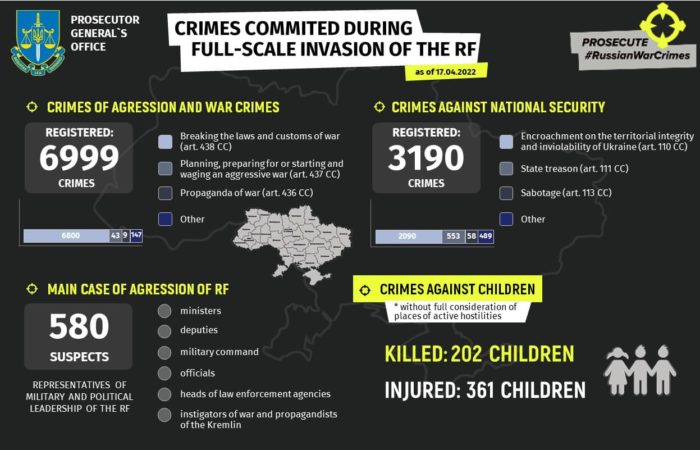
202 children were killed, and 361 children injured, the Office of the Prosecutor General of Ukraine reports that as of April 17. 6999 crimes of aggression and war crimes and 3190 crimes against national security were registered as of the same date. 1018 educational establishments are damaged as a result of shelling and bombings, 95 of them are destroyed fully.
Support
New EU sanctions on Russia to target Sberbank, Commission head tells the paper, Reuters reports. The European Union’s forthcoming sanctions on Russia will target banks, in particular, Sberbank, as well as oil, the head of the European Commission Ursula von der Leyen, told Bild am Sonntag on Sunday.
“We are looking further at the banking sector, especially Sberbank, which accounts for 37% of the Russian banking sector. And, of course, there are energy issues, she said. The EU has so far spared Russia’s largest bank from previous sanctions rounds because it, along with Gazprombank, is one of the main channels for payments for Russian oil and gas, which EU countries have been buying despite the conflict in Ukraine.”
Germany boosts military aid budget to €2 billion, DW reports. The German government launched its Capability Initiative in 2016 and the funds have been used in the past to support the military, but also the police and disaster control agencies. The size of the pot is now to be drastically increased due to the war in Ukraine, with reports suggesting more than €1 billion will be earmarked for Kyiv. The decision follows fresh pressure from Kyiv that Berlin expedites the delivery of heavy weaponry in preparation for the expected large-scale Russian offensive in the east of the country.
In Russia, the production of new tanks is stopped due to financial problems and lack of imported components, Defense Intelligence of Ukraine (DIU) claims. In Russia, the production of new tanks is stopped due to financial problems and the lack of imported components. The producer is trying to overcome the crisis caused by the imposed sanctions. Uralvogonzavod (Nizhny Tagil) is a Russian manufacturer of armored vehicles, primarily the main tank of the Russian Federation T-72. Since the beginning of the war in Ukraine, the company has faced numerous financial problems. Rising interest rates on loans, lack of funds to service foreign currency loans, rising prices and materials and components (including armored steel) – these and other problems have significantly complicated the production of most types of military equipment. Production of new equipment, including T-90 and T-14 tanks (Armata), is stopped.
New developments
- The peace agreement with Russia could consist of two separate documents, Ukrainska Pravda reports citing President Zelenskyy. “The peace treaty with Russia can consist of two different documents. One of them should concern security guarantees for Ukraine, the other – directly its relations with the Russian Federation. Moscow would like to have one agreement that addresses all issues. However, not everyone sees themselves at the same table with Russia. For them, security guarantees for Ukraine are one issue, and agreements with Russia are another. According to the president, the United Kingdom, the United States, Italy and Türkiye are ready to become Ukraine’s guarantors, but no one has yet given a final answer.
- All negotiations could end if Mariupol defenders are killed, the Washington Post reports citing President Zelenskyy. He said Saturday that negotiations between Ukraine and Russia could end if Russian forces killed all the Ukrainians defending the port city of Mariupol. Zelenskyy warned that if Mariupol is found to have suffered atrocities on the scale of those uncovered in Bucha and other cities, it could be the end of the negotiations. “There could be 10 Borodyankas there,” he said of Mariupol. Zelenskyy added that “the destruction of all our boys in Mariupol” could “put an end to any format of negotiations.”
- Russian Armed Forces offer militants in Mariupol to surrender – Russian Defense Ministry, TASS The Russian Armed Forces offer the militants from the nationalist battalions and foreign mercenaries blocked in Mariupol to end hostilities and lay down arms from 06:00 Moscow time on Sunday, April 17, their lives will be spared, Mikhail Mizintsev, chief of Russia’s National Defense Management Center, said on Saturday. According to Ukrainska Pravda, President Zelenskyy said that negotiations were underway to help Ukrainian defenders in Mariupol, but the Russians demanded that they surrender. (The claim that the “representatives of the Kyiv authorities categorically forbid them to lay down arms and surrender and threaten with subsequent executions under the ‘wartime’ conditions” might probably be the first building block of a coming narrative explaining why they all perished. – HPM).
- Moscow bars entry to Russia for UK’s Johnson, Truss, Wallace, Reuters Russia’s foreign ministry said on Saturday that it had barred entry to the country for British Prime Minister Boris Johnson, Foreign Secretary Liz Truss, Defense Secretary Ben Wallace and 10 other British government members and politicians. The move was taken “in view of the unprecedented hostile action by the British Government, in particular the imposition of sanctions against senior Russian officials,” the ministry said in a statement, adding that it would expand the list soon.
- Russia is willing to cooperate with the EU, but may reconsider relations, TASS Russia is seeking to maintain relations with the European Union, which is one of its largest commercial and economic partners, but might drastically revise these relations, Konstantin Kosachev, Deputy Speaker of the Federation Council (the upper house of Russia’s parliament), said on Friday. “I think that as long as it depends on our country, the issue of a breakup with the European Union will not be translated into practice. We are certainly interested in preserving these relations. In Kosachev’s view, when speaking earlier about the possibility of severing relations with the European Union, he commented on the EU steps against Russia, “which have very closely approached the red line.”
- Germany to spend €3 billion on floating liquefied natural gas (LNG) import terminals, DW Germany has vowed to cut its dependence on Russian natural gas in the wake of Moscow’s invasion of Ukraine. Instead, Berlin is seeking to boost supplies of LNG from key exporters Qatar, the United States and Australia. However, the country has no import terminals to receive the gas, which arrives by ship. Any permanent facilities will likely take until 2026 to build. The floating terminals could be positioned in the North Sea or Baltic ports by next winter, according to media reports.
Assessment
On the War
The Institute for the Study of War has made the following assessment as of Friday 15 April:
“Ukraine’s sinking of the Moskva was a significant event that has likely triggered intensified Russian air and missile attacks in retaliation, but the decisive operations of this phase of the war will still be conducted on the ground in eastern Ukraine. The commitment of the Black Sea Fleet’s naval infantry to the fight around Mariupol some weeks ago meant that Russian naval operations would play a supporting role in the conflict. Increased Russian air and missile attacks are also unlikely to have a decisive impact on the outcome of the war since there is no reason to assess that Russia has been holding enough air and missile capability in reserve to tip the balance if it is now committed. This report, and likely future reports as well, will thus remain focused on the ground operations, especially those in eastern Ukraine.
Russian forces continued to amass troops around Izium in preparation for continuing offensive operations in eastern Ukraine. The Russians continued small-scale attacks in the vicinities of Izium, Popasna, and the area around Rubizhne and Sievierodonetsk—sometimes with artillery, sometimes with mechanized forces. These attacks have not made significant gains so far. It is unclear if they are part of a rolling offensive operation into which Russian reinforcements will be fed as they become available or if they are setting conditions for a larger-scale, better-coordinated offensive that will start soon.
Fighting in Donetsk and Luhansk Oblast intensifies as 10 Russian attacks were reported in Donbas over the last 24hours – the largest number in several weeks.
Heavy shelling continues. The fire started in 3 high-rises & 1 house in Severodonetsk at night.https://t.co/bJppuGfa2r pic.twitter.com/iJyi7oilXg— Euromaidan Press (@EuromaidanPress) April 17, 2022
The specific terrain on which battles in eastern Ukraine will be fought may constrain the Russians’ ability to take advantage of the number of forces they are amassing for the attack. Eastern Ukraine is famous for being superb terrain for large-scale mechanized maneuver because of the World War II campaigns of the Wehrmacht and the Red Army. It is far from clear, however, that Russian forces will find it much more conducive to rapid decisive mechanized operations than other parts of the theater.
The Russians have struggled repeatedly to seize built-up areas rapidly or even to reduce them once encircled. They will have to seize several significant population centers to achieve their apparent objectives in Donetsk and Luhansk oblasts, however, including Sievierodonetsk, Rubizhne, Lysychansk, Sloviansk, and Kramatorsk, as well as several smaller towns. The difficulties they have encountered taking Rubizhne do not bode well for their rapid success against other built-up areas.
The ground itself is also challenging as it is crisscrossed by many small water features and, at the moment, still very muddy. The reinforcements the Russians are bringing into this part of the theater will help, of course, but large numbers of much fresher Russian troops struggled to take relatively small population centers north, west, and northeast of Kyiv even before getting into the Kyiv suburbs proper. The Russians must take the major population centers in Donetsk and Luhansk, however, if they are to achieve the operation’s stated goals.
Russian forces will likely continue operating along three primary axes of advance in Donbas: from Izium south via Sloviansk toward Russian-controlled Donetsk Oblast near Debaltseve; from Rubizhne and Sievierodonetsk southwest toward the Izium-Debaltseve highway; and from Popasna west toward that highway. They may open an additional axis of advance from near Donetsk City to the north toward Kramatorsk as well, according to the Ukrainian General Staff.
The Russian main effort currently appears to be from Izium southeast along the highway to Sloviansk. The drive west from Popasna is presumably meant to reach the Izium-Debaltseve highway, possibly setting conditions to encircle or drive off Ukrainian forces defending against a Russian advance from the Debaltseve area to the northwest. The purpose of the direct assaults on Sievierodonetsk and Rubizhne is less clear.
The Russians may be trying to seize those cities as part of the objective to seize Donetsk and Luhansk Oblasts, rather than waiting until they have been encircled and trying to reduce them at that point. They may alternatively be seeking to fix Ukrainian forces in that northeastern sector of the salient the Russians intend to encircle. The general pattern of operations and apparent movements of Russian reinforcements suggest that the drive from Izium to the southwest will be the main effort in this part of the theater but that the Russians will continue to attack on multiple axes that are not immediately mutually supporting.
Ukrainian officials report that Russia has concentrated as many as 22 battalion tactical groups (BTGs) in the vicinity of Izium, but the Russians will struggle to take advantage of that force concentration if they cannot open up parallel axes of advance—something they have notably struggled to do in other parts of the theater. Russian forces are apparently attempting to drive southwest from Izium toward Barvinkove, which could allow them to open up an axis of advance in addition to the main Izium-Sloviansk highway. But Barvinkove is a large enough settlement to delay the Russian advance if Ukrainian forces hold it, and the route from Izium to Barvinkove is not really parallel to the Izium-Sloviansk highway—Barvinkove is roughly 50 kilometers west of Sloviansk. Taking Barvinkove does not cut the only Ukrainian ground line of communication (GLOC) to Sloviansk, moreover, as another main GLOC to Sloviansk from the west runs through Kramatorsk, about 45 kilometers southeast of Barvinkove.
The individual Russian offensives in the east are thus unlikely to proceed dramatically more successfully than similar operations around Kyiv unless the Russians change their operational patterns significantly. The Russians could overwhelm the Ukrainian defenders by the sheer number of different axes of advance forcing the Ukrainians to spread themselves too thinly. But the Ukrainians’ demonstrated will and ability to hold much larger Russian forces at bay in built-up areas for a considerable time suggests that many if not most or even all of these Russian drives will stall. This discussion does not take account of the quality and physical and psychological state of the Russian forces, which we have considered in detail in previous reports, and which makes a sudden dramatic Russian offensive success even less likely.
Key Takeaways
- The Russians and their proxies appear to be preparing to declare victory in the Battle of Mariupol, as Donetsk People’s Republic (DNR) head Denis Pushilin opened a United Russia party office in the city.
- Russian reinforcements drawn from troops that had fought around Kyiv have appeared in eastern Ukraine. Those reinforcements have not received sufficient time to recover physically or mentally from their losses and defeat around Kyiv and are unlikely to generate combat power proportionate to their numbers.
Ukrainian officials claim that the Russians cancelled the deployment to Syria of one of the last combat units that had not previously seen combat in Ukraine and sent that unit toward Donbas.“
Russia could begin the next phase of its military campaign in Ukraine as soon as this weekend or early next week, NBC News reports citing two senior US defense officials. The officials, whose briefing was given under the condition of anonymity, said that the US is working to convince allies to send more artillery and ammunition to Ukraine so it doesn’t run out when the offensive ramps up.
In the article “Putin’s Ukraine Gamble Pivots to a Very Different Battlefield” published in The New York Times, Andrew E. Kramer, Eric Schmitt, Thomas Gibbons-Neff and Michael Schwirtz outlines the next phase of the war. After Russian forces were mauled in cities and towns in northern Ukraine, Vladimir V. Putin is shifting the focus of his invasion to the flatlands of Donbas, in the east.
There are fields instead of city streets, and farmsteads instead of apartment buildings. Open highways stretch to the horizon. The battles in the north that Ukraine won over the past seven weeks raged in towns and densely populated suburbs around the capital, Kyiv, but the war is about to take a hard turn to the southeast and into a vast expanse of wide-open flatland, fundamentally changing the nature of the combat, the weapons at play and the strategies that might bring victory. …}
With few natural barriers, the armies can try to flank and surround each other, firing fierce barrages of artillery from a distance to soften enemy positions.
“What we’re talking about is, no kidding, a conventional, very lethal battle of manoeuvres where Russian forces are going to attack Ukraine’s fixed positions on the ground that is more open,” said Lt. Gen. Ben Hodges, the former commander of the US Army in Europe. …
The plains would seem to favour Russia’s raw advantage in weaponry. But as a defending force, Ukraine has an advantage in striking from entrenched positions at Russian troops as they advance over open ground and into artillery range. …
Overall, Russia has increased the number of battalion fighting groups in the east to 40 — as many as 40,000 troops — from 30 this month, with more reinforcements on the way, Pentagon officials said. Moscow has withdrawn as many as 40,000 troops from northern Ukraine to reorganize, rearm and resupply them in Russia and Belarus, and is expected to move at least some to the east by driving through Russia in the next few weeks
Ukraine’s army in the east had been estimated at about 30,000 troops before Russia invaded. After repelling the Russian assault on Kyiv, the military’s elite units redeployed to eastern Ukraine, but estimating the size and strength of Ukrainian forces there now is difficult. The units are smaller and more mobile than Russia’s, and the government has revealed no details of their movements.
In this new phase of the war, the Ukrainians will need a new arsenal of weapons — particularly long-range artillery and multiple-launch rocket systems. They will also require more armored vehicles to protect their forces and to tow artillery pieces to the front lines. …
Perhaps the biggest difference from the northern phase of the war fought among towns, woods and hills will be the terrain. Military analysts are forecasting an all-out, bloody battle on the steppe. “There’s nowhere to hide,” said Maksim Finogin, a veteran of Ukraine’s conflict in Donbas.
The narrow tree lines provide scant cover for small units, but not much more, he said. “And we can be seen from above, by aviation and by drones,” Mr. Finogin added. “Artillery can strike at any moment.” …
Both sides will try encirclements, military analysts say. It will become an artillery war, fought at distances of dozens of miles, where Ukraine’s edge in the motivation and morale of its soldiers could be overwhelmed by the sheer numbers of Russian artillery pieces, tanks and attack helicopters. Moscow is expected to use this heavy firepower to batter enemy positions before sending in ground troops to try to seize them. … For soldiers, artillery battles on the open plains can bring instant death or become drawn-out, harrowing ordeals.
Both the Russians and Ukrainians use Soviet-designed heavy artillery systems, named for flowers or trees — the Acacia 152-millimeter self-propelled gun, the Tulip 240-millimetre mortar, the Carnation 122-millimeter howitzer. Their incongruous labels belie their lethal abilities; they can saturate areas the size of football fields with shrapnel.
The strategy on the steppe, now as in wars past, has been to outflank and surround enemy forces, then pummel them with artillery, as the Soviets did over this same terrain in World War II. …
Lesha, 43, a Ukrainian soldier who asked to be identified by only his first name for safety reasons, endured an encirclement in the town of Ilovaisk while fighting Russian troops who had intervened in Donbas in 2014.
“The surrounding forces draw in closer, tighten the flanks and then methodically destroy” those trapped inside with artillery, he said, recalling a strategy that nearly cost him his life.
During that siege in Ilovaisk, which lasted about five days, Ukrainian soldiers lay in shallow trenches or root cellars, he said, covering their ears with their hands and opening their mouths, to better endure the pressure waves of Grad rocket artillery landing yards away. …
However tragic, he said, Ilovaisk and similar battles taught the army and political leadership hard-won lessons. Ukrainian units are now resilient under fire, he said. Commanders pay no heed to local Russian cease-fire offers. And above all, he said, the army learned the need for long-range weapons to fight back in open spaces.
Despite the Russian advantage in troop numbers and armaments, open terrain offers at least one benefit to the Ukrainian defenders, analysts said: Whatever is trying to advance, whether a platoon of 30 soldiers or a battalion flanked by armored vehicles, will have to cross exposed areas.
And as Ukrainian forces have already shown, their willingness to destroy their own infrastructure, like dams to cause flooding or bridges to close roads, has proved effective in stalling Russian forces, leaving them vulnerable to counterattack.
In Donbas, it will be no different. Bridges, roads and fields all can be mined and possibly destroyed to channel Russian forces toward Ukrainian soldiers who are dug into defensive positions. They will be armed with anti-tank guided missiles and backed by artillery already pre-sighted on important pieces of terrain like road intersections. …
It may be weeks before the sides join in a major battle, and it also may instead become a series of incremental, lethal encounters lasting months, according to American, British and Ukrainian officials and military analysts. …
And the fight in the east will begin closer to supply lines stretching back to the Russian border; that could be key for a mechanized Russian army advancing in a major conventional assault across the countryside.
“They are now prepared to fight the war that they really want,” the retired Gen. Philip M. Breedlove, a former NATO supreme allied commander for Europe, said of the Russians. “They want to meet force on force in open fields and go at it.”
Consequences and what to do?
“War with the collective West and the liquidation of the Kyiv regime“. The occupation administration of Kherson is trying to convince the local population that Russia’s crimes in Ukraine are being committed for the benefit of the people, and that “Russia’s armed forces are not at war with the Ukrainian people”, DIU claims It says the special operation began because of “Western plans” to destroy the Russian and Ukrainian peoples. The war itself is called “an operation to eliminate the anti-people regime in Kyiv.” In leaflets distributed in Kherson by the Russian forces, the Ukrainians themselves and their chosen government are blamed for the Russian aggression: “The grief that befell you is the result of the criminal regime of the Kyiv regime.”
The leaflet confirms that the war has nothing to do with the mythical “defense of Donbas.” Its goal is the destruction of Ukrainian statehood and the occupation of all of Ukraine.
Assessment by Hans Petter Midttun
After more than 8 years of war, the USA and Europe have finally started introducing the measures that might have stopped a low-intensity hybrid war starting in 2014 from turning into a full-scale war in 2022. The delivery of weapons and ammunition, drones, personal protection, intelligence, situational awareness, and more, have both helped Ukraine defend itself as well as increased Russian costs. The defense aid has helped Ukraine restore a kind of deterrence that has forced Russia to adapt its campaign plan and possibly, in the short term, adjust its objectives.
Unprecedented sanctions and measures have also been introduced, turning Russia into the most sanctioned country in the history of mankind. “Russia is ambling toward a major default on its foreign debt, a grim milestone that it has not seen since the Bolshevik Revolution more than a century ago”. Sanctions are already hurting Russia’s economy and risks to domestic stability will increase as the war goes on and the economic and humanitarian costs mount. According to The White House, Russia’s GDP could contract up to 15% this year, and inflation is already spiking above 15%. And that’s before the West has introduced its most effective measures: the full disconnection of Russian banks from SWIFT and sanctions on Russian energy.
The prospects of a new EU package of measures including oil sanctions and the German decision to spend €3 billion on floating liquefied natural gas (LNG) import terminals, and to boost supplies of LNG are, therefore, crucial to bringing the Russian economy to its knees. While the measures will be gradually introduced, they send a message of a permanent policy shift and, consequently, a long-term impact on the Russian economy.
The question is, however, if Putin believes the policy change to be a temporary inconvenience or a potential lasting problem. If he believes the measures will end as soon as a ceasefire agreement is on the table, the measures will help change the course of the war.
Based on the experience from the last 15 years, Russia has no reason to believe that the USA or the EU will stay the course.
Additionally, if the Russian authorities believe their own propaganda, trusting in their own threat assessments, blaming the West for the Ukrainian “crisis”, believing that Russia is only conducting a “special military operation” (and not war) to “de-nazify” Ukraine and that the reported atrocities are all fake news, Russia might see its war (sorry: “special operation”) as both legitimate and proportional.
If their perspective is in fact that fundamentally distorted, they might fail to ascertain the full impact their actions have had on the West. They might believe that things will return to normal once they have “sorted out Ukraine”.
That is obviously not going to be the case. The decision to invest in new energy infrastructure marks a fundamental change in European energy policy. The EU is finally taking permanent measures to reduce its energy dependence on Russia.
It is time to wake up the Russian Federation. Bringing the military options back on the table – or at least discussing the option – will bring credit to the Western resole to stop the Russian aggression.
Read more:
- Bucha massacre. Ukraine urges ICC to gather evidence of Russian war crimes
- “The Russian military rape women, the dead are just being dumped,” evacuee from Russian-occupied city says
- “They killed my family in cold blood!” Russian military targets civilians fleeing bombardments
- “They talked to us like we were criminals” – how Russian occupiers deported me from Mariupol




